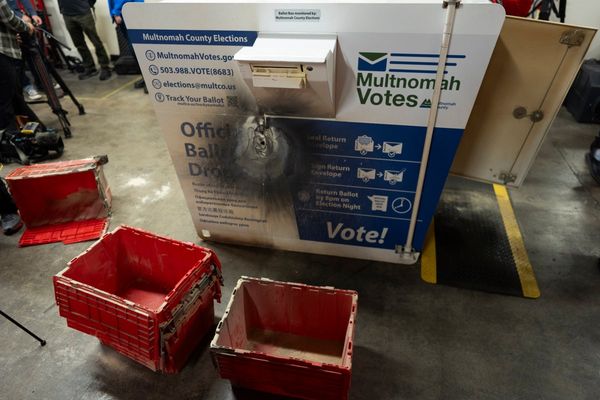
For the past 20 years, the most important, consequential international relationship has been between a rising China and a powerful United States. That remains true today, and it will likely be the case for many years to come, even as the nature of that relationship changes over time. Never static, ties in the past few years have shifted from engagement with an undercurrent of wariness to wariness with an undercurrent of engagement. Yet talk of a new Cold War—and the idea that Chinese-U.S. relations are at their worst since the two countries normalized diplomatic ties in 1979—is its own form of frenzy. And that way of thinking is forcing a 20th-century template of the Cold War between the United States and the Soviet Union onto a U.S.-Chinese relationship that could not be more different.
If ever there was a case of taking of simplistic view of the past and transposing it on the present, the Cold War framework applied to U.S.-Chinese relations is it. And it is not just a case of the misuse of history, although it is that. It also betrays a deep misunderstanding about what the actual dynamic is between the United States and China, one that appears to the shared even by U.S. officials. The two countries’ war of words is indeed hot. The technology competition is real, ranging from U.S. President Donald Trump’s administration’s intent to ban Chinese social media company TikTok from the United States and the long U.S. campaign against Huawei to the Chinese attempt to build its own internal telecommunications and Internet infrastructure. But the economic intertwinement between the two countries remains deep, complicated, and largely untouched by years of sanctions, tariffs, and bad words. The United States and China are not in a cold war. They are in a bad marriage, with no current option for divorce. That will remain the case for many years to come.
Of late, the bickering between the United States and China has certainly gotten much worse. Secretary of State Mike Pompeo has assailed Chinese President Xi Jinping as a “true believer in a bankrupt totalitarian ideology.” And the two countries have imposed an escalating series of tit-for-tat measures against each other, ranging from Chinese sanctions on U.S. senators to U.S. orders to close the Chinese consulate in Houston. That, in turn, has led policy experts and China watchers to speak of “a drift toward Cold War,” with potential for all the familiar hallmarks of last century’s Cold War between the United States and the Soviet Union: starkly opposed ideologies; proxy confrontations that then become proxy wars in other countries; mutually exclusive spheres of influence in which each attempts to freeze out the other; and a global diplomatic, propaganda, and economic offensive to line up allies and cut off the economic oxygen of the other side.
What these analogies completely miss, however, is the nature of the Chinese-U.S. economic relationship, which is so much more connected and intertwined than the U.S.-Soviet one ever was. That alone renders the Cold War template almost completely irrelevant as a guide to our present and future.
In 1950, the point of no return for conflict between the United States and Soviet Union, the United States represented about half of all global industrial production. Its Marshall Plan was funneling billions of dollars to Western Europe to reconstruct the war-ravaged economies there. But none of that money was flowing to the Soviet Union or the Eastern Bloc. During the following decades, the amount of trade between the two countries was so negligible as to be all but nonexistent. The only real constraint on hot war at the time was nuclear weapons. Instead, war was waged ideologically, economically via those exclusive spheres, and militarily only in peripheral countries such as Vietnam, Angola, and Nicaragua.
The U.S.-Chinese relationship, however, has evolved in the context of extraordinary economic interdependence. Even with two years of Trump administration tariffs on Chinese imports and mass disruptions on global commerce and movement of people due to the pandemic, bilateral trade in goods between the two countries is likely to be around $450-$500 billion this year, with close to another $100 billion in services. That is down from highs over the past few years, but about where it was in 2011. Not captured in those official statistics are the additional $1.1 trillion that China holds in U.S. Treasury securities and the hundreds of billions of dollars of capital stock and factories in China either owned, constructed, or maintained by U.S. companies. These companies not only manufacture goods such as the iPhone for export to the United States, but also sell goods to consumers in China.
The interlocking economies of the two countries, which the historian Niall Ferguson and economist Moritz Schularick once dubbed “Chimerica” and which I have called an economic “superfusion,” both enriched and imperiled U.S. companies and consumers. The opening of Chinese domestic markets after China joined the World Trade Organization in 2001 was a boon for U.S. companies, such as Yum! Brands, Ralph Lauren, and microchip and hardware companies that sold to a China that was not yet able to make the high-tech products itself. U.S. manufacturing took a hit, just as it had taken a hit from Taiwan and Japan in the 1970s and 1980s and from Mexico in the 1990s, but U.S. consumers benefited from a slew of cheaper products that made middle-class life more affordable. During and after the financial crisis of 2008, the United States was bolstered by Chinese investment in the United States in the form of bond and hard assets.
So why does the language of the Cold War persist? Many observers point to the technological competition between the two, with each distrusting the technology of the other. China has already walled itself off from the social media companies of the United States, and now both are attempting a tech decoupling that the pandemic is hastening, especially as China manages its health crisis through a deeply intrusive use of personal data to monitor and control the movement of its 1.4 billion people.
But even with tech tensions, the sheer scale of the countries’ economic interdependence remains largely intact. Over time, the frostiness may well lead to less and less economic commingling, but that will be measured in years, not months. Unless either China or the United States finds a spare $5 trillion to $10 trillion to rebuild completely independent supply chains, that structure of trade and manufacturing and mutual engagement is with us for a long haul.
Or perhaps the United States just needs a great enemy, as it used to have in the form of the Soviet Union. And it’s true that China is better cast than, say, al Qaeda or that amorphous nonstate thing called “Islamic fundamentalism” or “terrorism.” The U.S. national security establishment was set up in the late 1940s in order to contain and confront a unitary state power with a potent military. In that sense, China is a worthy successor to the Soviet Union. And what is faintly similar is that the two are locked in a great-power contest, in which China has moved to dominate the South China Sea as the United States did and still does in the Caribbean. The two countries do have ideological differences as well, but those are much less acute for the simple reason that China does not seem to seek to export any particular ideology other than state sovereignty.
In short, there is nothing comparable in today’s relationship between the United States and China to the 20th-century rivalry between the United States and the Soviet Union. With that in mind, the best course for the United States is to focus on itself. If there are fears of China stealing the intellectual property of U.S. companies or the data of U.S. citizens, then the U.S. government and relevant companies should invest heavily in innovation, cybersecurity, and data security. If the United States is concerned about a particular entity such as Huawei, then it needs to develop companies and technologies that can supplant what Huawei or other Chinese companies now supply.
None of that can happen with an executive order or a dramatic speech. It will take time, money, patience, and strategy. Stinging accusations and predictions of cold war catch attention, but they are like paper arrows. The U.S.-Chinese relationship is unlike any other between two grand nations in history in the degree of economic intimacy juxtaposed with genuine rivalry and distrust. Navigating tensions is hard work, and the history of other great powers in the past is of little help. In fact, it could do a great deal of harm if used simplistically. Best to let the Cold War be, and learn new tactics to manage a new rivalry for a different century.







